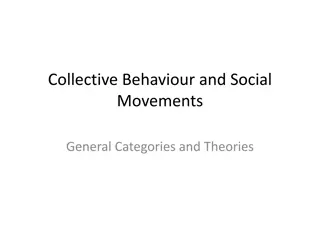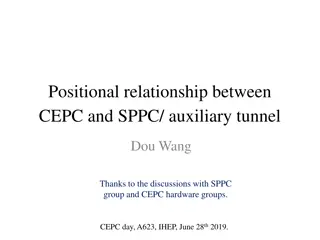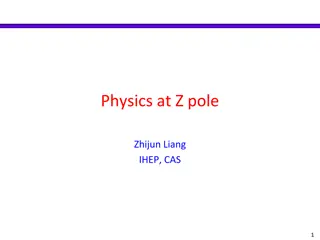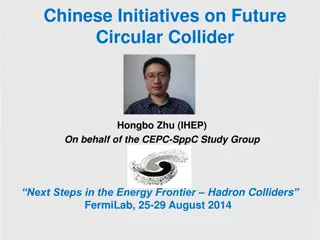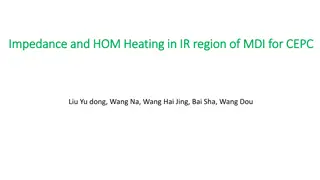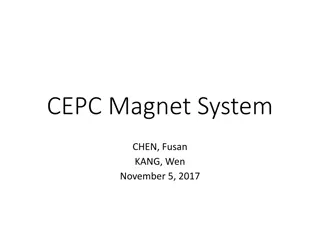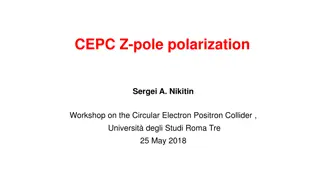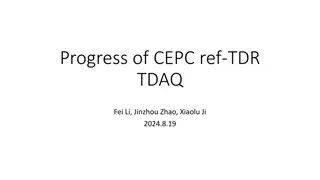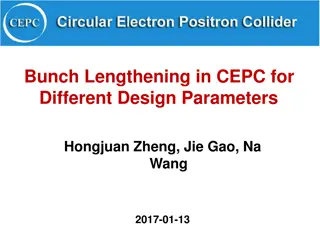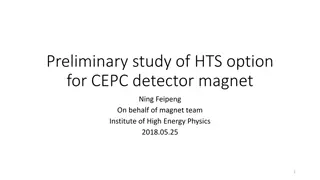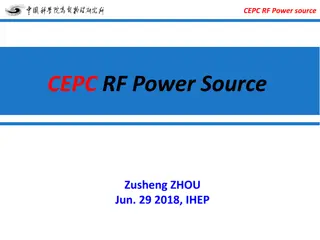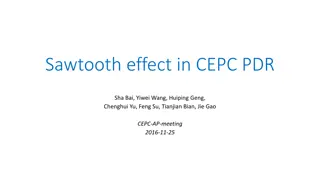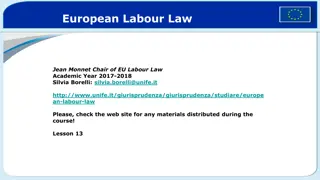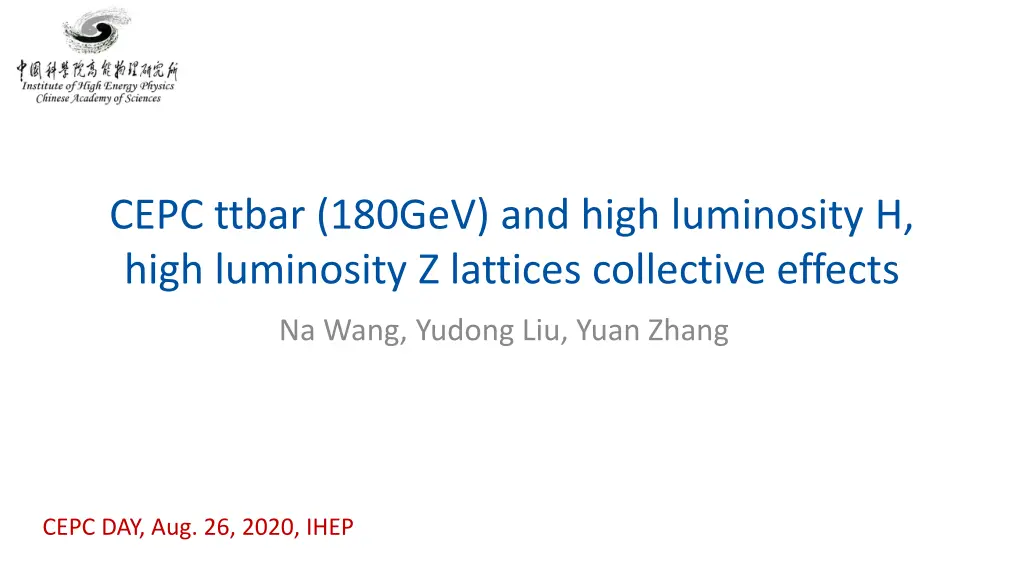
CEPC ttbar 180GeV and High Luminosity Higgs-Z Lattices
"Explore beam parameters, impedance requirements, and single bunch instabilities for the CEPC project concerning ttbar collisions, Higgs boson, and high luminosity scenarios. Delve into the collective effects and lattice designs presented by Na Wang, Yudong Liu, and Yuan Zhang at CEPC DAY. Understand the implications of beam energy, emittance, bunch characteristics, and more as outlined in the research."
Download Presentation

Please find below an Image/Link to download the presentation.
The content on the website is provided AS IS for your information and personal use only. It may not be sold, licensed, or shared on other websites without obtaining consent from the author. If you encounter any issues during the download, it is possible that the publisher has removed the file from their server.
You are allowed to download the files provided on this website for personal or commercial use, subject to the condition that they are used lawfully. All files are the property of their respective owners.
The content on the website is provided AS IS for your information and personal use only. It may not be sold, licensed, or shared on other websites without obtaining consent from the author.
E N D
Presentation Transcript
CEPC ttbar (180GeV) and high luminosity H, high luminosity Z lattices collective effects Na Wang, Yudong Liu, Yuan Zhang CEPC DAY, Aug. 26, 2020, IHEP
Main beam parameters From WangDou Parameter [unit] ttbar Higgs-High Lumi* Z-High Lumi Beam energy [GeV] 180 120 45.5 Lmax/IP (1034cm-2s-1) 0.34 5.0 101.1 Emittance (H/V) [nm] 2.4/0.0072 0.68/0.0014 0.52/0.0016 Beam current [mA] 3.52 16.8 841.0 Bunch number 28 214 10870 Bunch Population [1010] 26.1 16.3 16.1 Momentum compaction [10-5] Natural bunch length z(mm) 1.11 0.73 2.23 2.59 2.25 1.0 10-3 2.93 3.8 10-4 1.48 10-3 Natural energy spread Betatron tune x/ y Synchrotron tune 355.10/355.22 445.10/445.22 266.10/267.22 0.104 0.052 0.0457 Radiation damping [ms] 14/14/7 44/44/22 849.5/849.5/425.0 *The beam parameter design of High-Lumi Higgs is still under exploration. 2
Rough estimations Requirements on broadband and narrowband impedances. Parameter [unit] ttbar Higgs-High Lumi Z-High Lumi Beam current [mA] 3.52 16.8 841.0 Bunch number 28 214 10870 Bunch Population [1010] 26.1 16.3 16.1 Threshold on broadband |ZL/n|eff[m ] 16.4 5.3 0.9 Threshold on broadband ky[kV/pC/m] 87.6 58.6 11.9 ReZL G ReZ^ G /me-(2p fsl)2 f 5.2 10-4 Threshold on narrowband 136.9 4.6 e-(2p fsl)2 GHz 7.1 10-4 Threshold of narrowband Zy 54.3 3.0 No apparent showstoppers for ttbar & Higgs. Impedance budget Z||/n, m ky, kV/pC/m Total 11.4 20.2 3
Single bunch Instability for Z (1) Yuan Zhang Microwave instability and bunch lengthening Rarely induce beam losses, but may reduce the luminosity due to the deformed beam distribution and increasing of the beam energy spread. W/ impedance, W/O beam-beam lwith ZL [mm] ( l/ l0-1) e/ e0-1 2papE R|Z|| ese0 |eff 2sl 5.5 (90%) Ith= 4% n 30MW 30MW 4
Single bunch Instability for Z (2) Yuan Zhang Microwave instability and bunch lengthening W/ impedance, W/ beam-beam W/ RW W/ RW &BB lwith ZL [mm] ( l/ l0-1) e/ e0-1 5.5 (90%) 9.6 (230%) 4% 220% With beam-beam, much larger bunch lengthening and beam energy spread induced by the beamstruhlung. The scan of bunch lengthening with bunch charge will be further estimated. 5
Single bunch Instability for Z (3) Transverse mode coupling instability Fast instability, normally with beam losses. Considering bunch lengthening due to the impedance th=2Qsw0E /e b^,jky,j Q I0 j 30MW No mode coupling observed below or at the design bunch intensity. The instability will be further detuned when considering the bunch lengthening due to the beam-beam 6
Coupled bunch instability for Z (1) Transverse resistive wall instability The coupled bunch instability can be driven by the resonance at zero frequency of the transverse resistive wall impedance. Resistive wall impedance: Copper (3mm) with NEG coating (0.2 m) Elliptical cross section: 28mm (V) 37.5mm (H) Multi-layer analytical theory of cylindrical pipe is used Vacuum Cu NEG cu= 5.9E7 [S/m] NEG= 1.0E6 [S/m] NEG Cu Vacuum 7
Coupled bunch instability for Z (2) Transverse resistive wall instability Growth time of the most dangerous mode vs. damping factors Z-High Lumi Instability growth time [ms] 1.7 (~5 turns) Radiation damping [ms] 843 Bunch by bunch feedback [ms] 1.7(~5 turns) => Current feedback design can not damp this instability. => A more efficient damping of 2~3 turns is required. 8
Coupled bunch instability for Z (3) CBI due to RF HOMs 60 1-cell cavities will be used for High-Lumi Z. Courtesy of H. J. Zheng and J. Y. Zhai Monopole mode f (MHz) R/Q ( ) TM011 1165.574 32.6 TM020 1383.898 0.7 Cut off frequency: 1471MHz TM021 1717.475 9.9 TM012 1832.801 8.6 Dipole mode f (MHz) R/Q ( /m) TE111 844.738 139.9 TM110 907.592 210.0 Cut off frequency:1126 MHz TE121 1475.553 62.9 TM120 1662.599 9.4 * k mode = 2 f (R/Q) / 4 [V/pC] ** k mode = 2 f (R/Q) / 4 [V/(pC m)] 9
Coupled bunch instability for Z (4) CBI due to RF HOMs The requirements on the loaded Q for a single cavity are given by considering synchrotron radiation damping or feedback damping (transverse damping time: 5 turns, longitudinal damping time: 44 turns). Monopole mode f (MHz) R/Q ( ) Required Q (SR) Required Q (FB) TM011 1165.574 32.6 229 6.6E3 TM020 1383.898 0.7 9.0E3 2.6E5 TM021 1717.475 9.9 512 1.5E4 TM012 1832.801 8.6 552 1.6E4 Dipole mode f (MHz) R/Q ( /m) TE111 844.738 139.9 85 4.3E4 TM110 907.592 210.0 57 2.9E4 TE121 1475.553 62.9 189 9.6E4 TM120 1662.599 9.4 1.3E3 6.4E5 10
Two-stream Instabilities for Z (1) Beam ion instability Induce emittance blow-up and a positive tune shift along the bunch train. Filling pattern: CDR {Ntrain=120, Bunch spacing=25ns, Gap=270ns} High-Lumi {Ntrain=110, Bunch spacing=27.6ns, Gap=310ns} Emittance growth due to the beam ion interaction are foreseen Effectiveness of feedback on fighting ion instability need to be checked Parameters Z-30MW Lsep ion/c0 0.7 ion,ave[m-3] 3.1E11 e[ms] 0.1 H[ms] y 5.2 0.014 Build-up of the ions along the bunch train 11
Two-stream Instabilities for Z (2) YuDong Liu Electron Cloud With the CDR parameter, the average electron cloud density in dipole and drift region is around 3.2e10 m-3with SEY=1.6 & bunch spacing=25ns Comparable with determined by the single bunch instability. the threshold A lower SEY is expected with NEG coating Some safety margin can be gained for CDR. 12
Two-stream Instabilities for Z (3) YuDong Liu Electron Cloud Dependence of the electron density on SEY. With the High Lumi. Z Electron density Increase by a factor of 2 from bunch intensity Can be canceled by decrease SEY from 1.6 to 1.4 Instability threshold ??,? ?? ???=2???????/? 20% 3????? ? Rough estimation shows ecloud will not be a bottleneck, detailed simulations are underway. 13
Summary No apparent showstoppers for ttbar and High-Lumi Higgs. Main conclusions for High-Lumi Z include: Single bunch instability will not be an issues. Transverse resistive wall instability needs more efficient feedback damping: Damping time from 5 turns to 2~3 turns Rough estimation shows ecloud will not be a bottleneck, detailed simulations are underway. Emittance growth due to the beam ion effect are foreseen Effectiveness of feedback on fighting ion instability need to be checked with simulations. Requirements on the loaded Q of the RF HOMs are given More efforts are needed for the RF designs. 14


